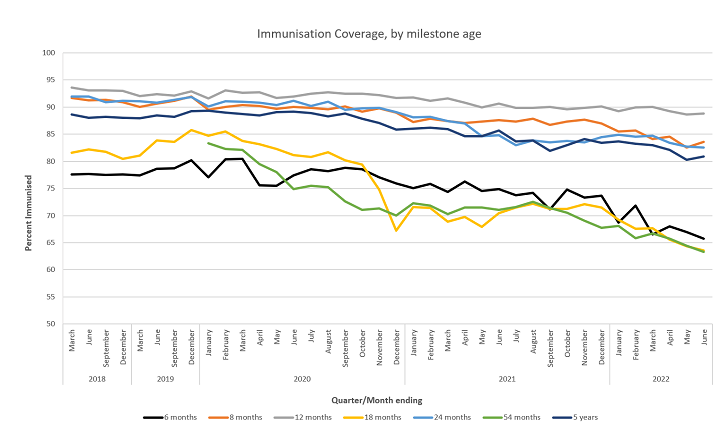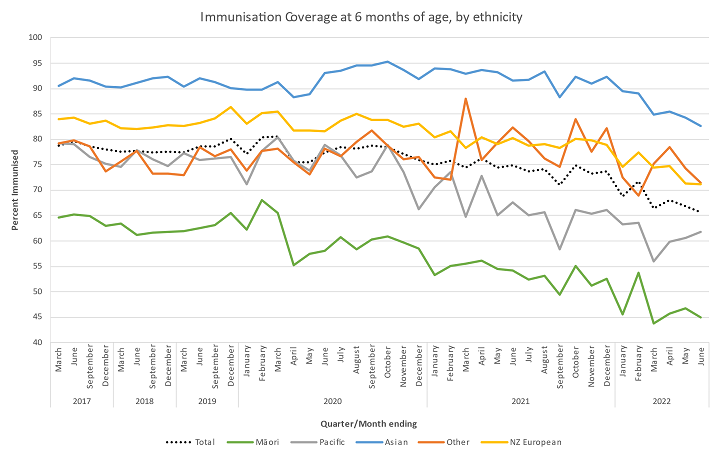WHO And UNICEF Raise Alarm On Drop In Childhood Immunisation, So Do We
Child immunisations have dropped so far during COVID that the World Health Organisation and UNICEF are raising the alarm, as is the Immunisation Advisory Centre, IMAC. Internationally 25 million children have missed out on life saving vaccinations and here in New Zealand Aotearoa we are seeing a similarly concerning trend.
“Planning and tackling COVID-19 should also go hand-in-hand with vaccinating for killer diseases like measles, pneumonia and diarrhoea,” said Dr Tedros Adhanom Ghebreyesus, WHO Director-General. In New Zealand we are seeing more and more outreach clinics where multiple vaccinations can be provided at once. IMAC supports this work continuing and expanding, especially the community outreach being done by Māori and Pasifika health providers, but the statistics paint a concerning picture.
Internationally, first dose measles is at its lowest level since 2008 internationally, down 24.7 million which increases the potential for outbreaks around the world including in New Zealand of course. We are at high risk of measles returning, and of a resurgence in whooping cough, both vaccine preventable diseases.
Dr Anna Howe, Research Fellow, Paediatrics: Child and Youth Health at the University of Auckland provides IMAC with immunisation coverage for children in New Zealand.
She says, “Here in New Zealand our childhood immunisations are also dropping, creating larger and larger equity gaps meaning those children most at risk are getting more and more at risk of getting sick or even dying from vaccine preventable illnesses. This is why it’s vitally important that parents and caregivers get their tamariki vaccinated without delay when they’re eligible, which provides them with life-saving protection.”
This graph from Dr Howe shows how much childhood immunisations have dropped by. As you can see, vaccinations at ages 6 months, 18 months and 2 years have dropped significantly.

Our other area of concern is the ethnic breakdown, which shows very concerning equity differences that need to be addressed, particularly around timeliness of receiving immunisations at the right age. Delaying the vaccination puts young children at high risk of some vaccine preventable diseases, in particular whooping cough and measles.
The overall coverage rates trend has dropped from nearly 80 percent coverage in 2017 to around 65 percent coverage this year in June. Māori and Pasifika rates are lower still and show an urgent need to support and expand the good work being done by Māori and Pasifika health providers working closely with their communities to reach those that can’t easily access vaccinations.
The leadership provided by the new Te Aka Whai Ora - Māori Health Authority, and Te Whatu Ora - Health New Zealand, will be critical in turning these statistics around.



 Brain Injury NZ: Creating Solutions - ID Card For People With Brain Injury Launched
Brain Injury NZ: Creating Solutions - ID Card For People With Brain Injury Launched University of Auckland: AI Leads To Breakthrough In Knee Surgery
University of Auckland: AI Leads To Breakthrough In Knee Surgery The Label: Independent Music NZ Announces Taite Music Prize IMNZ Classic Record 2025
The Label: Independent Music NZ Announces Taite Music Prize IMNZ Classic Record 2025 Protect NZ Psychology: Psychologists Warn Of Patient Risk From Undertrained Workforce
Protect NZ Psychology: Psychologists Warn Of Patient Risk From Undertrained Workforce PHARMAC: Pharmac Proposing To Fund Two Brands Of Oestradiol Patches
PHARMAC: Pharmac Proposing To Fund Two Brands Of Oestradiol Patches ASB Polyfest: 50th Anniversary Of ASB Polyfest Starts Next Week
ASB Polyfest: 50th Anniversary Of ASB Polyfest Starts Next Week